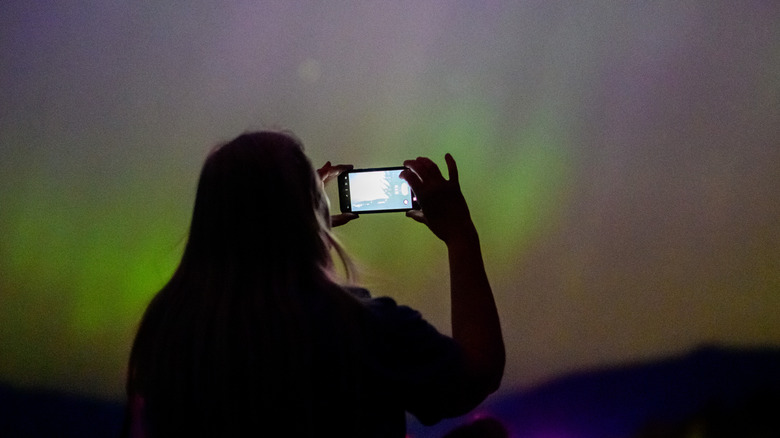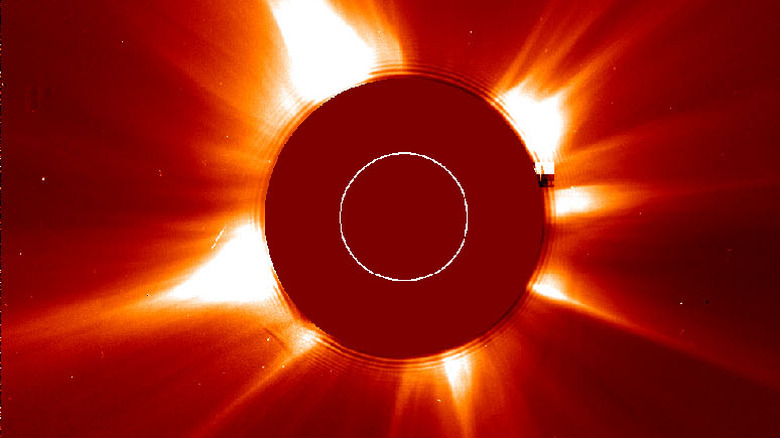If You Missed The Northern Lights, Here's When You'll Get To See Them Again
Has this ever happened to you? You wake up on a nice Saturday morning, fire up the coffee machine, and open your phone, only to find out that the sky exploded while you were in bed. You spend your whole day seeing new angles, takes, and pictures of the Northern Lights serving up absolute hits all the way down to Florida, and you commit yourself to absolutely, 100% not missing the show tonight.
So, you cancel all your Saturday night plans, drive your car out to an empty field, and stare up at the night sky, and you don't even catch a glimpse of a shooting star. Has that ever happened to you? It happened to Chris Chaston, a research physicist at Berkeley's Space Sciences Laboratory, who is a professional in all things auroral. The Friday night lights of early May 2024 caught a lot of us by surprise. So, when do we get a second chance to see them? Is there a northern light at the end of the tunnel? The odds are currently in our favor.
Chaston told the University of California Newsroom that there's a good chance for more "auroral action" in June 2024. His colleague, Yan Li, said that it's "reasonable" to expect more sightings in the next few years. The Northern Lights being visible in more southern locations requires intense solar storms, and those are on the rise.
We're entering our solar flare era
Or, "solar flarera," if you would. According to the United States' Space Weather Prediction Center (SWPC), the sun's solar cycle goes through periods of increased activity about every 11 years. We're currently on Solar Cycle 25, and it's predicted to reach its maximum between now and 2026. The peaks of these cycles see increased sunspot activity on the sun, which creates more solar flares that can cause larger geomagnetic storms on Earth. Northern Lights were seen as far south as Northern California several times in 2023 and popped up in the Northern United States in 2021, but nothing compared to the hullabaloo that took place most recently.
It took a massive geomagnetic storm to spread the aurora borealis to the wide geographic zone people enjoyed in early May. Predicting those storms is not an exact science. Scientists are confident that we're entering the peak of Solar Cycle 25. What they're less confident about is what exactly that means for Northern Light activity. Aurora chaser Melissa F. Kaelin told USA Today, "Humans still have a lot to learn about space weather."
Kaelin added that accurate predictions of what exactly will be visible usually can't be made until three days before the event. Her predictions are backed up by SWPC program coordinator Bill Murtagh, who said last year that space weather prediction is "decades behind" the forecasting abilities that predict Earth's weather — and meteorologists aren't always right, either.
Where to see the Northern Lights
Our current solar flare era has increased the chances that the United States will be basked in an eerie glow this year, but it's no sure thing. As Bill Murtagh told USA Today, "There are so many uncertainties, it makes it difficult to predict." Even if you went to southern Finland to see the lights, you might only get 10-20 days a year of visibility, and you'd probably have to wake up in the middle of the night. Even more celestial action must play out perfectly to see the Northern Lights in the continental U.S.
Remember the geomagnetic storm that lit up the night sky earlier in May? That storm was one of the strongest geomagnetic storms ever recorded. Between 1950 and today, a storm creating the same amount of geomagnetic activity as what was recorded on May 11th happened exactly one other time, in 1960 (via SpaceWeatherLive).
It sounds like we've got two choices. We can constantly monitor the airwaves, the SPWC's X account, and head out to empty fields on whims to see if the lights come back, or, we can do what Chris Chaston recommends: get a hotel this winter in Fairbanks, Alaska.


